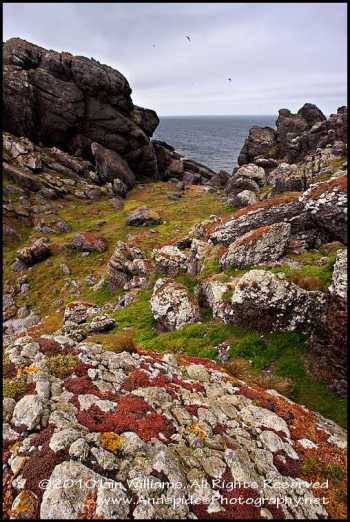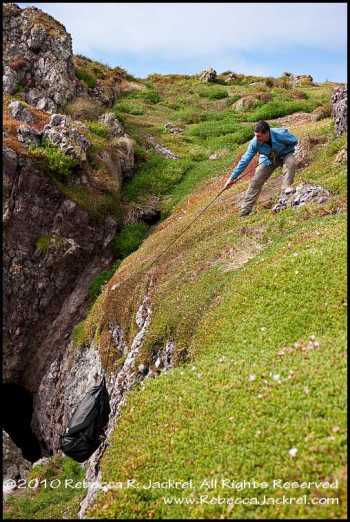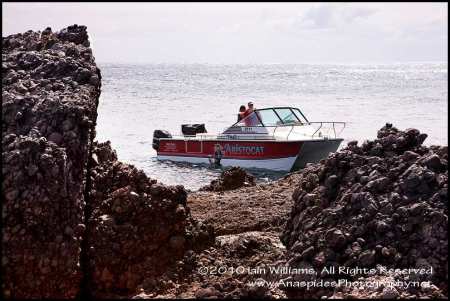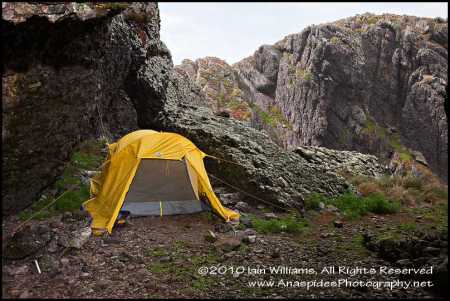Tasmanian Seabirds Field Trip - Albatross; Post 1
 Tuesday, February 9, 2010 at 10:53PM
Tuesday, February 9, 2010 at 10:53PM

This is the first segment of a series of posts to document a recent trip I conducted with another photoghrapher to a small uninhabited and remote island in Bass Strait off the coast Tasmania.
The purpose of our visit was to photograph the seabirds on the island; in particular the Shy Albatross (Thalassarche cauta), Fairy Penguin (Eudyptula minor) and Southern Prion (Pachyptila turtur).
LEFT: Succulent & lichen covered rocks. Two albatross can be seen in the sky.
The island is remote, not frequently visited, has no infrastructure and is out of communication range except when using high frequency radio or satellite phone. We had to be totally self sufficient for the time spent on the island, therefore, considerable effort went into logistical preparation for the one-week camping trip. In addition, extra water and food supplies were required to be taken, in case we became stranded on the island because of the unstable local weather patterns, which frequently cause sea conditions to be such that pick up via boat is not possible. Everything that was needed for the trip, including medical and emergency items,
had to be transferred from the mainland to the island via a 35 foot shark cat.
POOR WEATHER CONDITIONS
As it was, the jumping off date was cancelled due to large swells and 50-knot winds, however, on the following day a lull had developed between frontal systems. Our skipper decided that today was the day and we made a dash for the lee of the island navigating through 3-meter ocean-going seas.  As we approached the island, we made our first observations of shy albatross; the birds were completely at home in the rough and windy conditions as they skirted on the crests of large swells.
As we approached the island, we made our first observations of shy albatross; the birds were completely at home in the rough and windy conditions as they skirted on the crests of large swells.
To transfer the gear from the boat to the island was in itself out of the ordinary. The boat’s skipper had to position the shark cat in such a way that the bow rail was adjacent to a rocky outcrop. Then the equipment was passed quickly across the bow rail to a person on the rock – this was done to the symphony of the swell and several runs were made until all our equipment was disgorged onto the rock.
LEFT: Lowering equipment from the ridge to the mouth of the sea cave via rope and shackles.
LUGGING GEAR OVERLAND/ISLAND
The fun part then began as we had to man/woman handle everything to the top of a hill over relatively unstable rocks, along a small ridge, and then lower the gear via a rope to the entrance of a sea cave. Now, this may sound like an easy operation, but imagine “lugging” several 20-kilogram jerry cans of water, a battery for recharge purposes, tent, cooking equipment and food – not too mention 3 pelican cases of camera and video equipment! To complete this seemingly easy task involved a number of trips from the cave to the dropping off point and took 4 hours! Add to this the fact, although wearing copious amounts of sunburnt cream, the high UV still managed to eat through the cream causing us to get sunburnt and more dehydrated than normal.
 BASE CAMP AT MOUTH OF SEA CAVE
BASE CAMP AT MOUTH OF SEA CAVE
It was in this sea cave (at the far entrance) that we established a base camp.
LEFT: Shark Cat showing rocks that equipment was unloaded.
At first we thought it would be best to actually camp in the sea cave (as sealers had done 200 years earlier during the height of the Tasmanian seal industry), however, several reasons for not doing this were evident. Nearly every accessible portion of this small rocky island was covered in seabirds, nesting sites and burrows; the remainder was solid rock (for the geologists the rock was Owen conglomerate deposited around the Ordovician period). The other reason for utilising the cave was the weather - not so much the rain, but more the gale force winds  that regularly buffet this part of the coast. Despite having an exceptionally well constructed tent, I wasn’t pleased at the thought of being blown off into the southern ocean. The third reason was we noting several rather large boulders that had already fallen from the cave’s ceiling - and we didn't fancy having sleeping with one!
that regularly buffet this part of the coast. Despite having an exceptionally well constructed tent, I wasn’t pleased at the thought of being blown off into the southern ocean. The third reason was we noting several rather large boulders that had already fallen from the cave’s ceiling - and we didn't fancy having sleeping with one!
LEFT: Base camp at the mouth of the cave.
LITTLE RESPITE FROM WIND, SALT & DUST
Although the cave entrance did provide some respite from severe wind and rain, it offered little respite from humidity, sea salt and dust; within a few days all the gear was covered in dirt and our clothing was mattered with salt and grunge. My jacket at the beginning of the trip was relatively new and at the week’s completion the jacket reminded me of a unwashed World War Two combat smock that had been worn and used in several battles!
More to follow soon.......



Reader Comments (2)
Nice photography...
like it so much
Thanks for your kind words Shamima. Take care....Iain